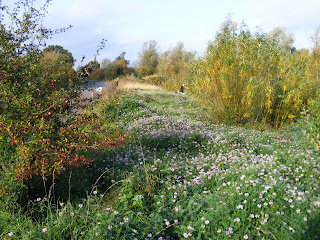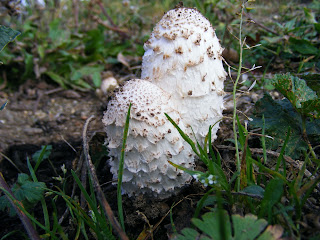As I walked back down the Heronry Trail, past Peter's Field by the row of conifers at Wray House Garden, I could hear the urgent whistles of nervous wigeon just beyond the trees; so despite being in a bit of a hurry, I popped over the little wooden bridge for a look. On the right of the path there is a fallen tree that lies in the water. Very close to the shore, there was my otter busily fishing among the submerged branches. It soon caught a small pike and settled down on a branch to eat it, tail first. I could still hear it munching away as I left. So now that I have seen one it's your turn, and I won't be jealous.
 |
| Piglet taken with a mobile phone. |
If the year was a day, this would be tea-time! November is traditionally a good time for berries and fungi, and there are plenty of both, but who would have expected wild flowers? This week there are still some colourful surprises to be found, especially in Peter's Field where you can still see white campion and deep blue cornflowers.
 |
| Purple toadflax |
Crown vetch is a creeping member of the pea family that has pinkish purple flowers. It scrambles over the ground forming a dense mat of vegetation, almost a foot thick, that obliterates all competition. Having formed a monocultural colony in a glade, it then starts to spread to the neighbouring bushes and small trees, scrambling up through the densest bramble and even reaching up into willow trees. It just has to go.
 |
| Crown vetch before..... |
 |
| .......and after. |
You may spot some brass tags on some of our trees. This means that we are monitoring them, usually because they might become a safety hazard. Ranger Matt Johnson led on this and is now worrying about how to find money to get the most urgent tree surgery done.
In every winter month, the waterbirds on all our lakes are counted as part of the national WeBS count which is coordinated by the BTO. Due to the low water levels, we have been able to access some tricky bank-sides in order to trim the willows to facilitate counting from viewpoints.
 |
| Shaggy Ink-caps |
Volunteers: Over 150 man days of volunteer effort contributed to the running of the centre, the reserve and the Autumn Watch event.
Coming Up: As well as hosting events on the site, The Friends of Paxton Pits sometimes goes on the road to reach people in the wider community around St Neots. On November 19th at 7.30 in the United Reformed Methodist Church we have An Evening of Song. Huntingdon Male Voice Choir will be supported by Take Three Folk. Tickets are going fast at £8.00. (From Paxton Pits or the St Neots Museum).
 |
| Volunteer Gerry Senior trying to look busy while we clear bramble from an orchid patch. |
In November our wildfowl numbers should increase, even though we already have more ducks than usual . I'm hoping for smew and goosanders before too long. We have water-rails on the site now and can expect more. Because it has been a lemming year in the far north, we might expect to see a short-eared owl or even a rough legged buzzard. They are being seen in the county already. Will we see bramblings on the bird tables this year? There's always something to look forward to, even if the weather (and the economic) forecast is gloomy.